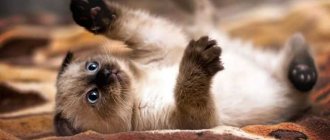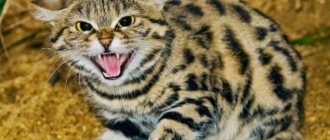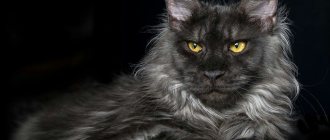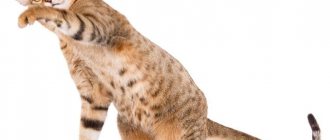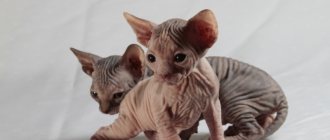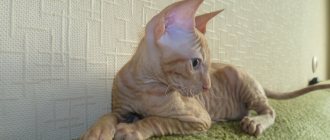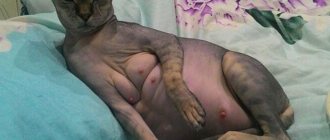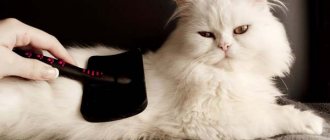Navigation
DescriptionEconomic importance for humansPositiveNegativeHow to care for and maintain?The bobcat is a special type of wild cat that can be trained to live in a houseHealth conditionAmerican BobtailCharacter featuresPros and consDetailsHabits and behavioral characteristicsRequirements for keeping at home Description of the American BobtailHistory of the origin of the American Bobtail breedReproductionGeneral informationHabitat in the wildExternal characteristicsThreat of extinctionGender new maturation and reproductionFeatures of nutrition
How to care and maintain?
When keeping a bobcat cat at home, you need an outdoor enclosure. It must be iron up to 3 meters, closed with a strong network or lattice on all sides. The first side is made from strong planks bound with tin. Adjacent to this wall is a house intended not only as a shelter in bad weather and a place for giving birth to a pregnant cat, but also as an area where the animal is confined during cleaning or replacing decorations. The door is made from a strong sheet of steel and must be secured using a cable system. A comfortable enclosure area for a cat is 5 by 5 meters.
The bobcat is a special type of wild cat that can be trained to live in a house.
The species of lynx has always attracted the attention of lovers of exotic pets. But not all lynxes can be kept in the house; many of the representatives of the species cannot be tamed. However, with early education and active socialization, the bobcat bobcat may well become a fairly tame animal with the authentic appearance of a wild cat. The wild red lynx is a distant relative of the common lynx. So distant that now species do not even interbreed, either in the wild or in zoos.
The bobcat lives in the United States and Canada, and is sometimes found in southwestern Mexico. The red lynx came to the mainland back in the Pleistocene era through the Bering Strait. It was after migration that the red lynx began to form as a separate species of lynx, although initially it was very close to the Eurasian lynx.
History of the discovery of the species
Scientists had a long debate about whether to classify this species as Lynx rufus or Felis rufus, that is, they could not decide to which genus to classify this strange creature, clearly belonging to the cat family.
The bobcat is believed to be descended from the Eurasian Lynx, which migrated to North America through the Bering Strait during the Pleistocene; these predecessors arrived as early as 2.6 million years ago.
The first wave penetrated the southern part of North America, which was soon cut off from the north by glaciers. This population evolved into the modern Red Lynx about 20,000 years ago.
A second wave of migrating feral cats arrived from Asia and settled in the north, evolving into the modern Canadian subspecies. Sometimes hybridization between the Bobcat and the Canada Lynx may occur. Also read about the Canadian lynx on the Mister Cat portal.
Thirteen subspecies of Bobcat have been historically recognized based on morphological characteristics:
- r. rufus belongs to the authorship of Schreber, the animals inhabit the eastern and midwestern United States.
- r. gigas was described by scientist Bangs; the cats inhabited territories from northern New York to Nova Scotia and New Brunswick.
- r. floridanus was characterized by zoologist Rafiensky, Lynx are found in the southeastern United States and inland in the Mississippi Valley, to southwestern Missouri and southern Illinois.
- r. superiorensis described by Peterson and Dovning, the animals live in the western Great Lakes, including Upper Michigan, Wisconsin, southern Ontario and most of Minnesota.
- r. baileyi, recreated by the scientist Merriam, predators occupied the southwestern United States and northwestern Mexico.
- r. californicus, species deciphered by Mearns, California range west of the Sierra Nevada.
- r. mohavensis, by B. Anderson, Bobcats are found in the Mojave Desert in California.
- r. escuinapae characterized by Allen are native to central Mexico, with a northern extension along the west coast to southern Sonora.
- r. fasciatus, studied by scientist Rafiensky, Bobcats are residents of Oregon, Washington, as well as areas west of the Cascade Range, northwestern California and southwestern British Columbia/
- r. oaxacensis was introduced to the world by naturalist Goodwin, the animals are found in Oaxaca.
- r. pallescens was described by researcher Merriam, wild cats live in the northwestern United States and southern British Columbia, Alberta and Saskatchewan.
- r. peninsularis, the authorship of the species belongs to Thomas, the distribution area of the animals is Baja California.
- r. texensis, author of the Mearns study, Bobcat distribution area is western Louisiana, Texas, south-central Oklahoma and southern Tamaulipas, Nuevo Leon and Coahuila.
This division of Bobcats has been questioned by many experts, given the lack of clear geographic breaks in their ranges and the minor differences between subspecies.
In the latest revision of feline taxonomy in 2022, the Carnivore Classification Task Force recognizes only two subspecies based on phylogeographic and genetic studies, although the status of the Mexican Bobcat Lynx rufus esquinapae remains under review:
- Lynx rufus rufus, animal range eastern Great Plains, North America.
- Lynx rufus fasciatus, animal distribution area of the western Great Plains, North America.
Health status
Such pets can suffer from calcivirus. Large cats of this breed may have:
- Infectious diseases. Enteroviral rhinotracheitis, panleukopenia, calicivirosis, lichen of various types.
- Non-communicable diseases. Manifestations of inflammation of the stomach or intestinal tract are possible (therapy consists of improving the menu, prescribing medications), stagnation in the intestines (treatment with the use of castor oil, bran).
- Surgical diseases. Big cats in captivity often have elongated claws. If the animal’s body is weak and the cat lives in a damp room, there is a possibility of pneumonia or the development of bronchitis. Treatment consists of improving living conditions, taking medications and vitamin C.
Advantages
If we talk about the advantages of such equipment from the Bobcat company, it is worth starting to consider it from the chassis. Loaders of this category have all-wheel drive, pneumatic chassis. Four-wheel drive ensures high performance on uneven surfaces and rough terrain. Most telehandler models boast an operating speed of 30 km/h, which is very good for such machines.
Excellent maneuverability, as well as high maneuverability, are ensured by changing operating modes. "Bobcat" is a loader that can:
- control only the front wheels;
- turn the front and rear wheels in different directions - the so-called “track to track” class turn;
- use a mode in which the wheels turn simultaneously in one direction - “crab motion”.
Depending on the model and configuration, it is possible to mount it with a 2- or 3-section boom. A special device is installed on the head for attaching various attachments. The cab of Bobcat telehandlers is characterized by free space inside and at the same time excellent sound insulation. Additionally installed protection systems:
- the first is necessary in order to protect the operator when the machine overturns;
- the second is aimed at preserving the integrity of the cabin from objects accidentally falling from above.
Character traits
Adult bobcat cats like to rest and sleep a lot.
They enjoy playing with their owners and going for walks. However, it is better for them not to come into contact with children, since during the game they can accidentally harm the child’s health. The playfulness of lynxes is high. Due to their large size, they can destroy everything in their path. Activity occurs mainly at night. Small kittens should be kept indoors; only after one and a half years can they be transferred to an outdoor enclosure. Return to contents
Bobcat telehandlers
Bobcat is a company that, in addition to front loaders and mini-format equipment, is engaged in the development and production of other units. Bobcat telescopic loaders are a completely universal class of mechanisms, characterized by high technology and reliability. They can easily replace some construction vehicles, for example, a truck crane or a light-duty aerial platform. Additional attachments allow you to unify special equipment. After installing certain mechanisms, the machine can work with:
— bulk materials;
— hard soils;
— boxes and pallets;
- remove snow and leaves.
Advantages and disadvantages
An animal can become domesticated if raised from a young age.
The main advantages of keeping such cats include their exclusivity and rarity. If an animal has grown up next to a person from a young age, then it will be a good friend and become a full member of the family. The American cat is fun to play with, walk, feed, and care for. The main disadvantages are the high cost of the animal (price of the cat, food, maintenance, care) and due to the presence of hunting instincts, you need to behave carefully with your pets and not let small children get close.
Details
Habits and behavioral characteristics
The favorite territories of the red lynx are forests: deciduous, coniferous, mixed - it doesn’t matter to the cat, just as the density of the forest is not important. But in general, the animal can live almost anywhere, as evidenced by its presence in desert Texas and swampy Florida. The bobcat will live wherever there is something to eat and something to hunt.
Even the proximity of a person does not scare away the short-legged lynx. It is not uncommon for an individual to settle not far from a farm, or become a visitor to the backyards of the outskirts of areas of the so-called “single-story America.” The only thing the animal cannot tolerate is a high level of urbanization; the population is accustomed to the rest, just like the ubiquitous raccoons.
Initially, the population was concentrated in the southern part of Canada, but over time it chose the warmer climate of the United States, and it was inconvenient for the species to compete in the snow with the Canadian lynx. The small feet of the paws sink into the deep snow; the dense soil underfoot is much more suitable for the bobcat lynx.
As for the lifestyle, it is exactly the same as that of most wild small cats. The bobcat is a solitary animal, preferring not to share its hunting grounds with anyone. Lynxes actively mark their territory and use urine, secretions, and paw secretions.
The variety of living conditions and the need to adapt made the bobcat a versatile climber and swimmer. The house is built either in a hollow, a hollow log or in a dense bush. At the same time, the tendency to build a nest is very low. It’s good for a cat to just be in a secluded place; dragging dry grass for bedding is unusual.
Price
Bobcat loaders have gained particular popularity and love among construction companies. Their price varies depending on the configuration and the availability of additional equipment. The minimum cost starts from 1.3 million rubles. For those who cannot afford to purchase a new forklift, there are many offers for the sale of used equipment. The cost of cars on the secondary market starts from 850 thousand rubles. Many organizations offer to rent a Bobcat, in which case you will need to pay 7,400 rubles for 8 engine hours with a full tank of fuel and an operator. The most common model today is the Bobcat S530. It is the most versatile, and at the same time it is not very expensive to operate.
Description of American Bobtails
The first thing that comes to mind when looking at the beautiful short-tailed Yankee beans is that their ancestor is the lynx. However, bobtails inherited their color, athletic build, expressive eyebrows and other characteristics from ordinary cats.
Pets almost always have a strong, heavy body of medium or large size. Animals reach their maximum weight and size by two or even three years. Moreover, females are smaller than males. The latter can weigh from 5.5 to 7.5 kg, while cats on average stretch only 3-5 kg.
American Bobtails are distinguished by a stocky, strong body, a straight back, a wide chest and a well-developed muscular system similar to that of colorpoints. The paws are always proportional to the body. In this case, the hind limbs are slightly longer than the front ones. Strong, large paws have a rounded shape.
One of the first distinguishing features of the breed is the tail. It should be short and slightly widened at the very base. Its shape can be any: straight or slightly curved with kinks. But in any case, this part of the body retains high mobility and flexibility. If you look at the American Bobtail from the front, the raised tail is always noticeable. But if it is too long (or, conversely, almost absent), then this is an argument for disqualification. It is believed that it is impossible to find two cats with exactly the same tails.
The wedge-shaped, wide head has a prominent forehead and pronounced cheeks. The width and length of the muzzle are almost equal to each other. Snowbobs are distinguished by strong jaws and a wide, well-developed chin.
The ears are wide apart and rounded at the ends and are of medium size. A characteristic feature of American Bobtails is the presence of fluffy long hairs on the inside of the ear.
An expressive look and beautiful large almond-shaped eyes always attract attention and make the image of the animal attractive and charming. The color of the iris most often harmonizes with the color of the coat.
The classic color is tabby, that is, a striped pattern. Although the standard includes other variations of this feature. Coat colors range from light beige to dark red. Brown or almost black stripes stand out against this background.
The coat of American Bobtails is quite thick and somewhat harsh to the touch. The undercoat is moderate and consists of medium soft hair. If a cat has a coat as smooth as silk, then this is considered a fault. Currently, there are both long-haired purebred cats and short-haired ones.
Care and maintenance of cats
Caring for bobtails is not particularly difficult. More obstacles may arise at the very first stage, when you need to purchase a purebred kitten. The thing is that the American bobtail is quite widespread in America, but in other regions of the planet it is rare. Breeding and breeding of purebred representatives is still carried out only in the USA.
But if, after all, luck smiles and a real American bobtail settles in the house, then keeping this fluffy miracle will be a simple and enjoyable task. Cats need periodic walks in the fresh air. But at the same time, you definitely need to keep an eye on them, since the natural instinct for a free life can make itself felt.
Longhaired American Bobtails require regular brushing. There must be a scratching post in the house. Approximately once every 10-12 days, the pet needs to check its claws and, if necessary, grind them down so that they do not interfere with the soft step.
Diseases of the breed
This breeding line is considered one of the healthiest in the cat world. Purebred pets do not have hereditary diseases. However, if a close relative or an animal of unknown pedigree was involved in the breeding, then there is a risk of developing certain diseases. Most often this is:
If fed improperly, bobtails can develop diabetes. This most often occurs when cats are fed predominantly carbohydrate foods. To prevent this from happening, their food should include more meat.
Conclusions about the breed
American Bobtails are rightfully considered the favorites of their owners. Outwardly, cats have retained the features of their wild ancestors, but at the same time they are distinguished by their kind and affectionate disposition. If we add to this high intellectual abilities and an extravagant hunting look, then the authority of the breed rises even higher. All the features of the character and appearance of fluffy cats and cats evoke only pleasant emotions in everyone who has encountered them at least once in life. This unusual combination of characteristics makes snowbobs unique and inimitable creatures.
History of the origin of the American Bobtail breed
This is one of the youngest varieties bred by breeders. Its story begins in 1960, when the American couple Sanders found a small kitten with a unique appearance in the vastness of Arizona. Finding a wild cat with a short tail like a lynx was a real miracle. It was this feature that later became one of the main ones in the standard. The cat was named Yodi and became a pet.
After some time, babies were born from him, inheriting not only long hair, but also a short tail. This was proof that this trait is not only genetically fixed, but also dominant. Friends of the Sanders, who are professional breeders, suggested using this unique chance to breed a new variety of cats.
However, further crossing of American bobtails with each other almost led to their degeneration. The breeders had to choose new work tactics. Since inbreeding did not give the expected results, only wild animals with short tails and domestic pets of pure, that is, non-hybrid, lines began to be selected for selection. This is what allowed us to end up with a very strong and healthy breed.
Initially, all cats born had long hair. But as a result of numerous crossings, animals with short hair were born. Since all other pedigree characteristics were preserved in such kittens, adjustments were made to the description of the American Bobtail standard for their sake. Hard work continued for decades and, finally, by the end of the twentieth century it was officially crowned with success. It was recognized by several international organizations and clubs of felinologists.
Analogs
If we consider the S530 model, then there are no domestic analogues of such a machine. The Bobcat loader, whose technical characteristics are in some sense unique, is an indispensable machine in almost any industry where loading operations are required. Among foreign ones, two models can be classified as analogues: Kramer 350, as well as Mustang 2056. But still, they are far from the parameters that the Bobcat has. All machines that are presented on the Russian market are supplied in the so-called winter configuration, with washers, windshield wipers, and also with a heated operator’s cabin. It is worth noting that if necessary, the door can be easily dismantled.
Reproduction
The reproduction system is polygynous. Males and females interact for the short time required for courtship and copulation. Mating occurs in early spring, although timing is variable. Pregnancy lasts 60-70 days, resulting in the birth of about 3 kittens. The cubs open their eyes when they are 10 days old. Breastfeeding lasts about 2 months. Then, the females bring meat to their offspring and teach them everything. At the age of about 8 months, lynx cubs become independent. Males do not take part in raising the young.
Sexual maturity in females occurs at the age of one year, and in males at 2 years.
General information
Habitat in the wild
After climate change, part of the population remained cut off from its ancestors by the ice belt and has existed as an independent population for 20,000 years. Due to the distribution of cats across the continent, their unpretentiousness to habitats and skills to hunt anywhere and everywhere, the bobcat received as many as 13 subspecies in its gene pool. They all differ in size, fur density and habitats. The largest subspecies, of course, live in the forests of Canada, and the smallest in Mexico. Even from state to state, the red lynx in the United States has its own characteristics that meet the requirements of the territory of residence.
Wide distribution, alas, does not mean a large population of the species. The bobcat lynx is still valued for its luxurious fur and is shot by hunters. The most deplorable situation is for the population in Mexico, where control over the activities of poachers leaves much to be desired.
INTERESTING: The American red lynx only dislikes steppes and plains without tall grass. She adapts all other natural conditions to suit her life with great success.
External characteristics
The bobcat lynx is twice as small as its ancestor, the Eurasian lynx. This is due to the fact that the new species found itself in conditions that did not require a long search for prey in vast snow-covered areas.
The sizes of all 13 subspecies vary between 60-120 centimeters, at the withers 30-60 centimeters. Weight depends on the season, gender, and subspecies. Typically this ranges between 6 and 16 kilograms.
But size is not the main difference between a bobcat; the species has very short paws. Therefore, with a significant body length, the height at the withers is small. As a joke, the red lynx can be called a dachshund among lynxes. The feet of the species are also small, especially in individuals that do not live in snow.
The hind legs are slightly longer than the front legs, but due to the structure of the joints, the difference in the stance is not visible. The croup is raised in relation to the loin, but the visual length of the hind limbs is noticeable only when the animal moves and the knee joint straightens.
Most individuals have a characteristic red spotted fur, but in some regions it is quite normal for the animal to have reddish-brown or gray fur. The short tail has white spots, most often the very tip of the tail is colored this way.
Mr. Cat recommends: description, characteristics, area
The red lynx Lynx rufus is a medium-sized North American cat that emerged during the Irvingtonian stage of the continent about 1.8 million years ago.
Containing two recognized subspecies, the bobcat ranges from southern Canada to central Mexico, including most of the contiguous United States.
The bobcat is a small predator that adapts well to any living conditions, living in forest areas, as well as in semi-deserts, on urban outskirts, in open areas in forests and swamps.
The animal has a very wide range of habitats, but Bobcat populations are vulnerable due to predation by coyotes and domestic animals.
With a gray to brown coat, whiskered muzzle, and black tufted ears, the Lynx resembles other medium-sized species of the genus of the same name.
The predator is on average smaller than the Canada Lynx, with which it shares part of its range, but several times larger than a domestic cat. It has distinct black stripes on its front legs and a very short tail, almost a pompom, which is how the animal got its second name, Bobcat.
The bobcat resembles all other members of the Lynx, but is the smallest of the four species.
Its coat can come in a variety of shades, although brown to grayish-brown colors are more common, with black stripes on the body and dark markings on the forelimbs and tail.
The spotted pattern acts as camouflage. The pointed ears end in short black tufts. Typically, there is a light area of fur near the mouth, chin and lower body.
Bobcats in the desert areas of the southwest have the lightest coats, while those in northern forested areas have the darkest.
Kittens are born with a formed color and already have their own spots, which are unique to each individual. Several melanistic Bobcats have been spotted in Florida. They appear black, but the dot pattern is still visible.
The muzzle appears wide due to the disheveled hair under the ears. Bobcat's eyes are yellow with black pupils. The nose is pinkish-red in color, while the back of the nose is grey, yellowish or brownish-red.
The pupils are round, black and dilate greatly during nocturnal activity to maximize light perception.
The length of an adult lynx is from 47.5 to 125 cm from the head to the base of a very short tail, which seems to “bounce” when the predator moves and adds 9-20 cm to it.
An adult animal reaches from 30 to 60 cm at the withers. Males can weigh from 6.4 to 18.3 kg, with an average of 9.6. Females range from 4 to 15.3, averaging 6.8 kg. The largest Bobcat, whose weight was accurately recorded, weighed 22.2 kg, although according to unverified data they reached 27 kg.
The bobcat is a muscular, compact animal, and its hind legs are longer than its front legs, which makes its gait unique.
The cat is larger in its northern range and in open habitats.
The Red Lynx prefers forested areas - deciduous, coniferous or mixed, but unlike other species, it does not depend exclusively on dense forest.
Biotopes range from the wet swamps of Florida to the desert lands of Texas or rugged mountain regions. The animal may have hunting territories near agricultural areas if there are rocky ledges, swamps or forested areas there.
The Lynx population depends, first of all, on the availability of food supply. Other main factors when choosing a habitat type include climatic conditions, the availability of places for rest and shelter, dense soil for hunting and movement, and quiet areas of existence.
The animal can appear in the backyards of human homes in the “urban outskirts”, where the urbanization zone and natural habitat intersect. If a Bobcat is being chased by a dog, it will usually climb a tree.
The bobcat's historical range was from southern Canada, throughout the United States, and as far south as the Mexican state of Oaxaca, and it still persists throughout much of that area.
In the 20th century, the species was thought to have lost territory in the US Midwest and parts of the northeast, including southern Minnesota, eastern South Dakota and large parts of Missouri largely due to habitat changes resulting from modern agricultural practices. Although no further bobcat populations are believed to exist in western New York and Pennsylvania, there have recently been numerous confirmed sightings (including dead individuals) in southern and central New York.
Additionally, small populations have been confirmed in northern Indiana, and one male was recently killed near Albion, Michigan. In early March 2010, a Bobcat was spotted in a downtown Houston parking lot and later captured by animal control authorities. By 2010, predators appeared to have recolonized many states except Delaware.
Animal populations in Canada are limited due to the depth of the snow and the presence of the Canada lynx.
The bobcat does not tolerate high snowdrifts and waits out heavy storms and snowstorms in sheltered areas; it lacks the large, soft paws of the Canada lynx and cannot distribute its weight as effectively on the snow.
What kind of paws does a Canadian lynx have?
The bobcat is at a disadvantage when its range overlaps with that of a larger feline predator.
In northern and central Mexico, the animal is found in dry scrub, pine and oak forests, its range here ending in the tropical southern part of the country.
Threat of extinction
The skin of a red lynx is a valuable trophy, fetching several thousand dollars on the black market. And the lynx’s secretiveness and fearlessness in front of humans only adds excitement to poachers. Another reason why this species is hunted is the damage bobcats cause to farms. They attack birds and small animals, which is why farmers, at the first opportunity, try to eliminate the animal that has gotten into the habit of visiting their lands.
At the moment, the red lynx is listed in the Red Book as a species that is threatened with complete extermination. Attempts are being made to restore the bobcat population and reproduce the individuals present in zoos, but so far these efforts have not brought much results.
Interesting Facts
The Red Lynx does not really like to swim, but it feels great in the water and moves at the speed of a good human swimmer, and can dive remarkably well.
In the myths of ancient North American Indians, the Bobcat is closely related to the coyote. These beasts represent two opposing elements in the tales, fog and wind.
The Red Lynx is now listed on the second schedule of the Convention on International Trade in Species of Wild Fauna and Flora and is not considered endangered, but hunting and trade must be carefully controlled. The animal is regulated in all three countries of its range, and is found in a number of protected areas in the United States, its core territory.
Today, the estimated population size exceeds 1.5 million individuals. For these reasons, the United States petitioned CITES to remove the cat from Appendix II.
1111
Puberty and reproduction
Bobcats usually begin breeding by their second summer, although females may become sexually active much earlier.
The dominant male moves around his territory with the female and mates with her several times, usually from winter to early spring, it depends on the location of the individuals, but in most cases matings occur in February and March.
A couple can behave differently; quarrels, affection, and chasing each other are not excluded. Other males may be present during copulation but remain uninvolved. Although later the female is able to have sexual intercourse with other males.
During courtship, the usually silent cat may make loud cries, hisses, or other sounds.
In a female, the estrous cycle is 44 days, and estrus lasts from five to ten days.
Bobcats remain reproductively active throughout their lives, breeding from winter to spring.
Sometimes the second litter is born as early as September. The female makes her home in a confined space, usually a small cave or hollow log.
She raises the litter alone. One to six, but usually two to four, kittens are born in April or May after approximately 60 to 70 days of gestation.
At birth, the baby lynx weighs from 270 to 340 g and is about 25 cm in length. By his first birthday his weight is already 4.5 kg.
Babies open their eyes by the ninth or tenth day. They begin to explore their surroundings at four weeks and are weaned at about two months. After three to five months, they begin to leave the den with their mother.
The cubs are able to hunt on their own from the autumn of their first year and usually disperse soon after. In Michigan, however, researchers observed that the young remained with their mother until the following spring.
The average lifespan of a Bobcat is 7 years and rarely exceeds 10. The oldest male in the wild, according to video recorder observations, was 16 years old, and the oldest animal in captivity was 32 years old.
Nutritional Features
An adult bobcat needs to eat 2 kilograms of meat products including bones per day.
The basis of feeding wild cats at home is considered to be not very fatty beef. In order to improve protein diversity, animals are given raw chicken eggs and exclusively sea fish. To improve the functioning of the gastrointestinal tract, wheat or rye bran, vegetable oil, and barley sprouts are added to the diet. From natural food, adult cats are certainly offered “live food” - killed hares, mice, wild birds. Feeding occurs once a day. It is necessary to carry out a weekly fasting day for the animal; only fresh purified water is allowed. The diet plan is as follows: 3 days - meat, 1 day - fish, 2 days - “live food”.
for cats in the wild cat which wild cat wild cat paws the appearance of a cat lynx bobcat – lynx bobcat with Bobcat lives everywhere bobcat got lynx bobcat the difference between bobcat All breeds of cats beautiful breeds of cats TOP 10 breeds of cats ancient breeds before
photonorthernpredatordogvideorufusstreetwebsite
